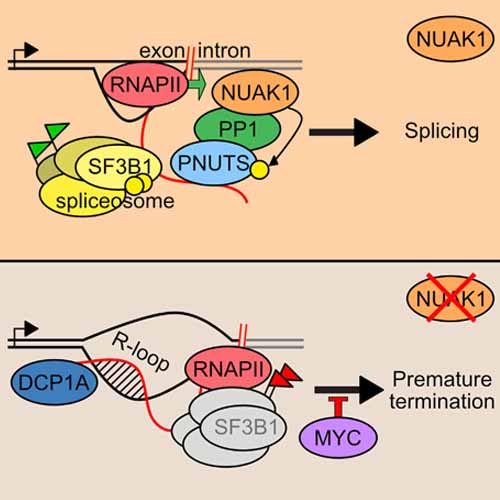Localized Inhibition of Protein Phosphatase 1 by NUAK1 Promotes Spliceosome Activity and Reveals a MYC-Sensitive Feedback Control of Transcription
2020-01-31
Giacomo Cossa, Isabelle Roeschert, Florian Prinz, Apoorva Baluapuri, Raphael Silveira Vidal, Christina Schülein-Völk, Yun-Chien Chang, Carsten Patrick Ade, Guido Mastrobuoni, Cyrille Girard, Lars Wortmann, Susanne Walz, Reinhard Lührmann, Stefan Kempa, Bernhard Kuster, Elmar Wolf, Dominik Mumberg, Martin Eilers
Molecular Cell, 2020, Vol. 77, Iss. 6, P1322–1339
Deregulated expression of MYC induces a dependence on the NUAK1 kinase, but the molecular mechanisms underlying this dependence have not been fully clarified. Here, we show that NUAK1 is a predominantly nuclear protein that associates with a network of nuclear protein phosphatase 1 (PP1) interactors and that PNUTS, a nuclear regulatory subunit of PP1, is phosphorylated by NUAK1. Both NUAK1 and PNUTS associate with the splicing machinery. Inhibition of NUAK1 abolishes chromatin association of PNUTS, reduces spliceosome activity, and suppresses nascent RNA synthesis. Activation of MYC does not bypass the requirement for NUAK1 for spliceosome activity but significantly attenuates transcription inhibition. Consequently, NUAK1 inhibition in MYC-transformed cells induces global accumulation of RNAPII both at the pause site and at the first exon-intron boundary but does not increase mRNA synthesis. We suggest that NUAK1 inhibition in the presence of deregulated MYC traps non-productive RNAPII because of the absence of correctly assembled spliceosomes.








